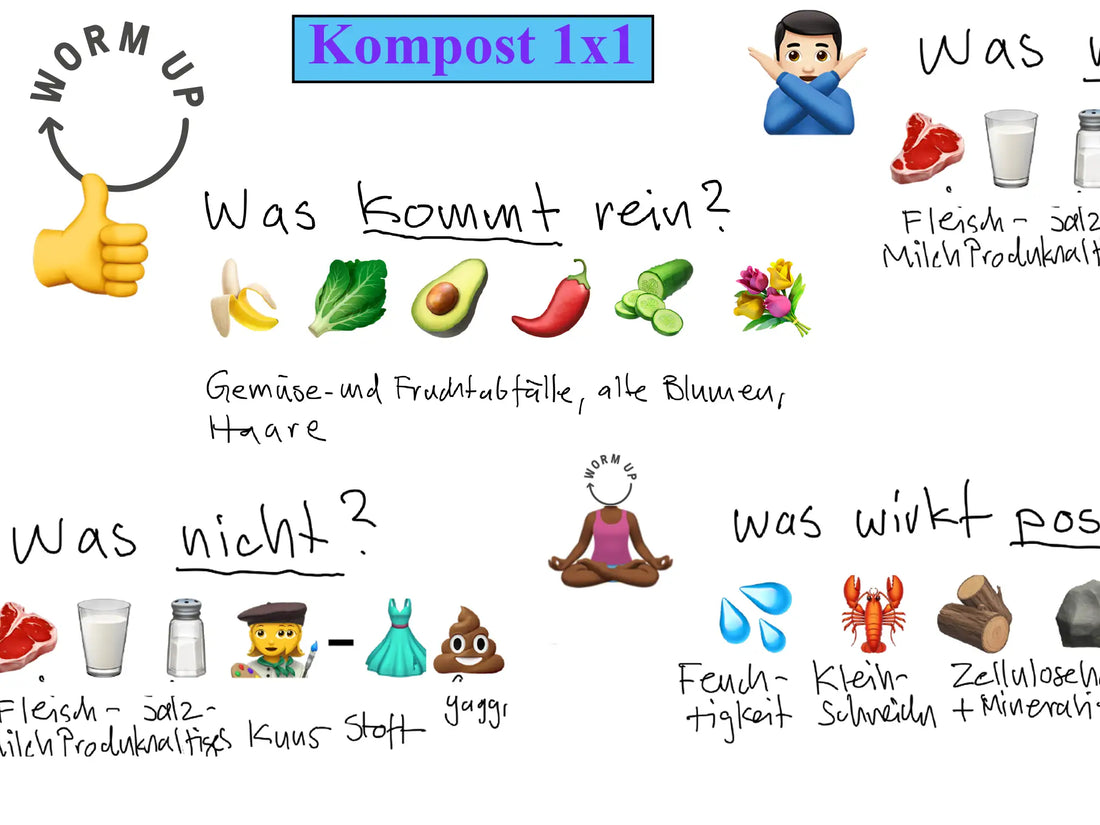Worm composting is an efficient method to transform organic waste into nutrient-rich fertilizer. Various factors play a crucial role in creating optimal conditions for the worms and supporting the composting process. Here's an overview of the most important factors.
Key Factors in Worm Composting
- Worm food
- Moisture
- Oxygen supply
- Temperature
- pH Level
1. Worm food
The input material has the greatest impact on the ecosystem in the worm composter and affects all other factors directly or indirectly. With adjusted feeding, you can thus specifically create the desired conditions in the composter.Tip: Find information on the properties of different wastes on our worm food list.
- The worm food for worm composting directly influences the quality of the final product. A balanced mix of green (nitrogen-rich) and brown (carbon-rich) material is crucial.
- The C/N ratio (carbon-to-nitrogen ratio) plays an important role here, as it affects the decomposition of organic materials by microorganisms. The ideal C/N ratio is between 25-30:1. As a rule of thumb, add about 300 g of woody, dry waste (carbon-rich) to 1 kg of kitchen scraps (nitrogen-rich).
- Adding minerals is important for the composting process and ultimately for the quality of the compost. Land soil, rock dust, or our Mineral Mix are rich in these minerals.
2. Moisture
Moisture in the compost is vital for the worms. An optimally moist environment promotes the decomposition of organic material and allows the worms to feed.
- The optimal moisture in a worm composter is usually between 70% and 85%. Regular watering or adding moist material like fruit and vegetable scraps increases moisture, while adding dry material like soil or cardboard reduces it.
Further information:
3. Oxygen Supply
Worms need oxygen to survive and process the compost. Adequate ventilation of the compost is therefore essential.
- A balanced mix of worm food (C/N ratio) creates enough gaps for optimal oxygen supply.
- Choosing a breathable material for the composter, like clay or wood, also promotes oxygen flow.
4. Temperature
Just as the seasons influence the activities of nature, the temperature in the worm composter determines the decomposition speed. Low temperatures slow down life, while activity increases with rising temperatures.
- An optimal temperature between 15-25°C accelerates decomposition without harming the worms.
Further information:
5. pH level
The pH level measures acidity or alkalinity and plays a central role in the balance of ecological systems. A balanced pH level creates ideal conditions for microbial processes and supports the health of the worm population.
- A neutral to slightly acidic pH level (6.5-7.5) is optimal for worm composting. An incorrect pH level can stress the worms and inhibit the composting process.
- The pH level can be regulated by adding aids like eggshells, lime, or our Mineral Mix.
Further information:
Correlation of the factors
Composting with worms is simple – the processes that take place are complex. To create optimal conditions for worm composting, it's helpful to understand the interrelations of the various factors. The mix of worm food not only affects the C/N ratio but also the moisture, pH level, and oxygen supply of the compost. The choice of composter also influences moisture and oxygen supply.

Worm food and moisture
- The mix of worm food directly affects the moisture in the compost. A balanced ratio of green and brown material helps maintain moisture in the compost.
- Most kitchen scraps lead to a gradual acidification in the composter. Therefore, we recommend regular addition of basic-acting aids like finely crushed eggshells, lime, or our Mineral Mix.
Worm food and pH level
- The composition of the worm food determines the compost's pH level. A high proportion of acidic materials can lead to a lower pH level, while alkaline materials can raise it.
- Most of the waste produced in the kitchen leads to gradual acidification in the composter. We therefore recommend the regular addition of alkalising additives such as eggshells (finely crushed), lime or our Mineral Mix.
Worm food and oxygen supply
- The structure and composition of the worm food influence the aeration of the compost. A balanced ratio between coarse and fine materials usually leads to optimal aeration and thus an efficient composting process. Coarse material like branches or roughly chopped plant remains creates air channels in the composter and promotes ventilation, while finer material increases the surface area for colonization by microorganisms and worms.
- We recommend chopping the worm food, e.g., with scissors. Well-chopped materials promote a rapid decomposition process. Too fine chopping, e.g., using a mixer, can impair aeration, as smaller particles tend to compact and leave less room for air circulation, leading to oxygen deficiency and putrefaction.
Worm food and temperature
- An increase in temperature should be avoided. Adding larger amounts of nitrogen-rich waste to the composter leads to heat development due to increased microbial activity. Unlike in classic hot composting, heat development is not desired in worm composting and harms the worms. Therefore, the layer of added waste should never be thicker than 4 cm.
- An exception to the rule is composting outdoors with large composters during the winter. There, heat development can be utilized to keep the composting process active.
Further information:
Moisture and oxygen supply
An appropriate moisture level is important for oxygen absorption in the compost. Too moist material can lead to anaerobic conditions and thus to putrefaction.
Composter and oxygen supply/moisture
Indirectly, oxygen supply and moisture can also be influenced by the choice of composter. Wood and especially clay, as opposed to plastic, allow good oxygen exchange.
Composter and temperature
The location of the compost container can influence the temperature. A protected, shady place is ideal to prevent extreme temperatures. If the composter is outside, we recommend bringing it indoors during winter.

